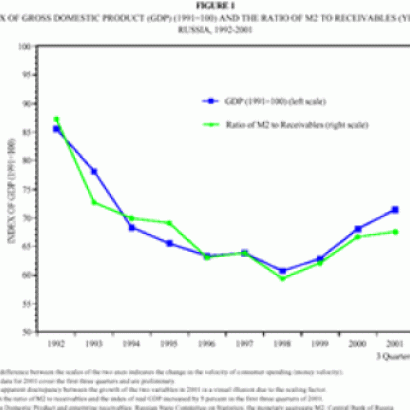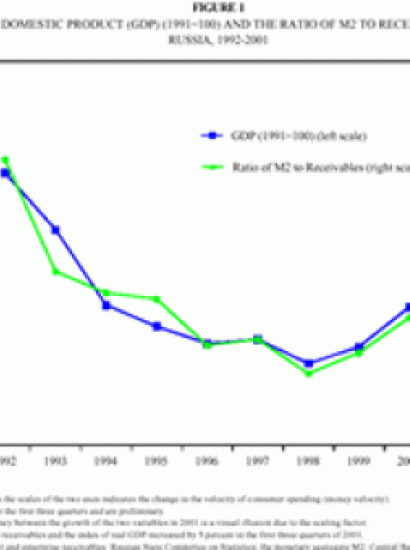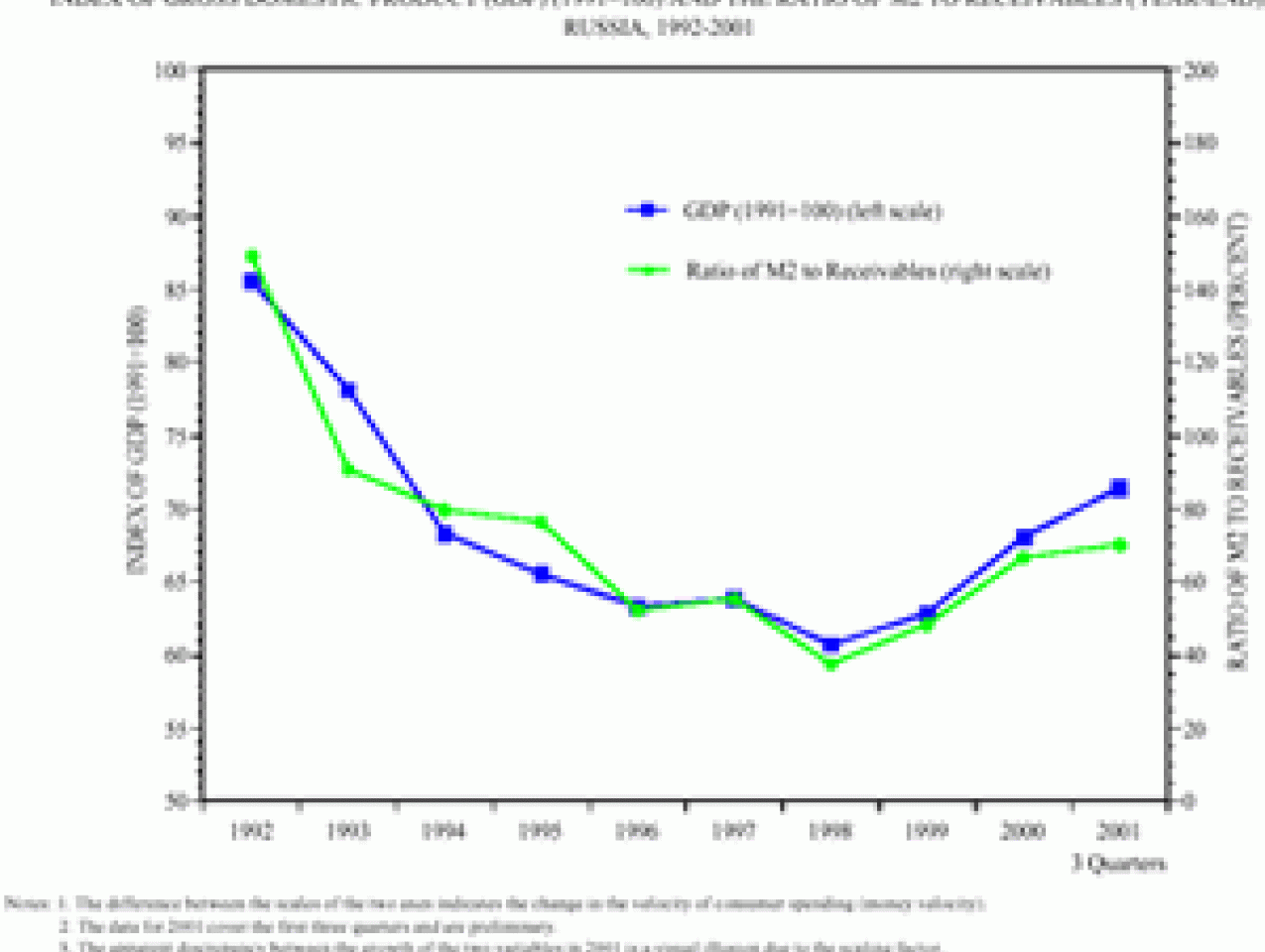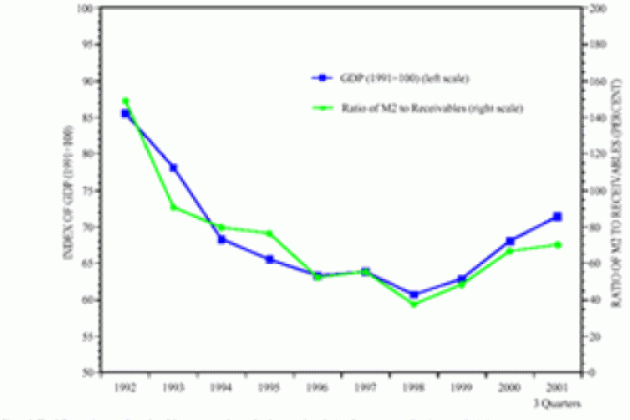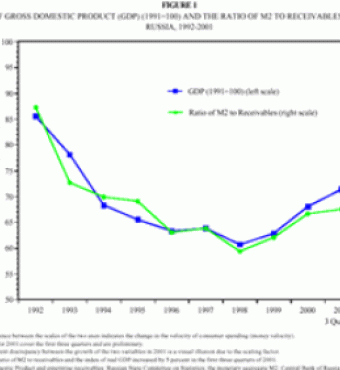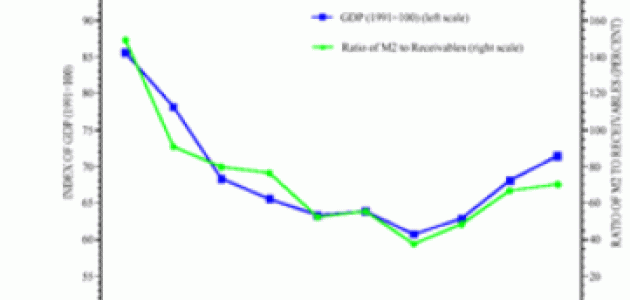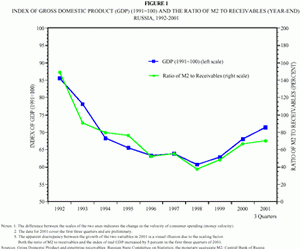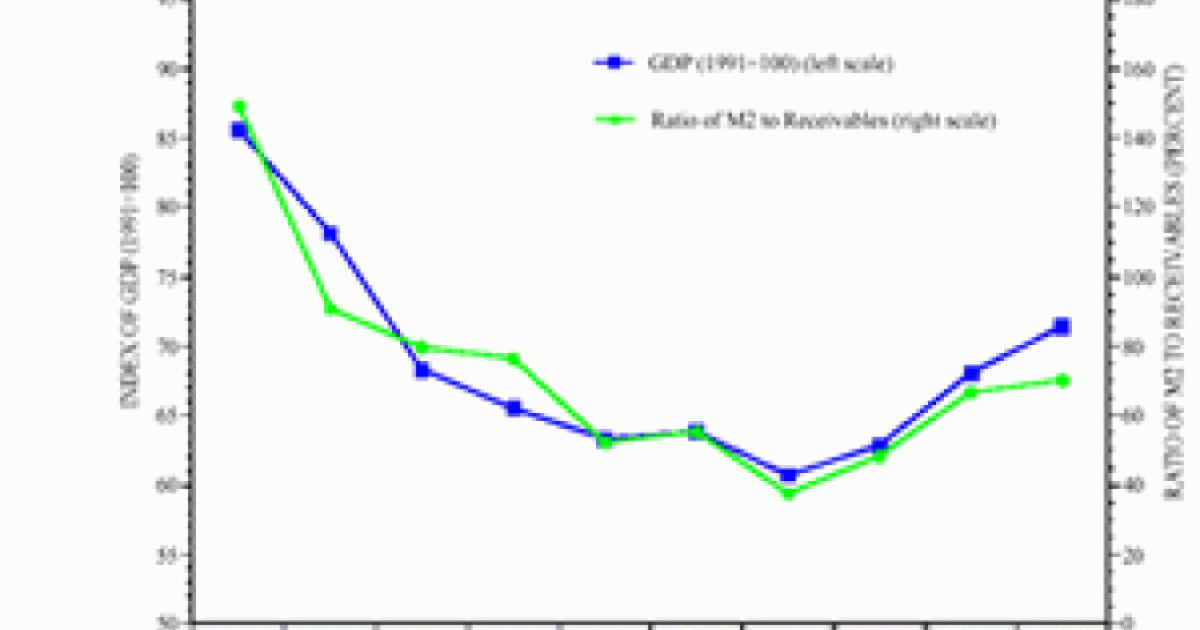- Economics
- Security & Defense
- US Defense
- International Affairs
- Terrorism
Terrorism has replaced economic and other issues as the top agenda item for the meeting between presidents Bush and Putin at the ranch. Russia has become a partner in the war against terrorism. President Putin also expressed his commitment to prove that Russia is a reliable economic partner of the West, favoring Russia's participation in an integrated and liberalized world economy. The West, for its part, welcomes Russia's development and its recent growth—3.5% in 1999, 8.3% in 2000, and about 5% this year.
Putin's government has recently enacted several market-friendly new policies. Pride of place goes to the 13% flat tax on personal income that took effect this year, followed by a reduction in the corporate rate from 35% to 24%. While potentially important in the long-run, these measures are peripheral to more fundamental changes that are required to sustain growth.
The collapse of Communism has resulted in a new economic system in Russia that may be more detrimental to growth than central planning. At its heart is a fiscal system the world has never seen before. This is a fiscal system in which enterprises are free to tax the public, extracting subsidies at will, with the government playing a secondary role. The resulting extent of redistribution of income to finance inefficient operations is ubiquitous. Conveniently, enterprises use what is at hand, namely, the payment system. They make private payments at public expense, in the process socializing private payments. A brief dissection follows as to how it works.
Economic growth or contraction in Russia's economic system are determined by the change in the length of enterprise payments. The intuition is simple: If it takes 3 months to pay for the bundle of real output (GDP), the existing cash flow buys 4 bundles of output per year. If it takes 4 months, the existing cash flow buys only 3 bundles of the same output per year. In this example, GDP contracts by 25 percent. This accounting truism would hold in any economy, but is irrelevant in most Western economies where the average length of payments is short (e.g., 28 days in the U.S.) and stable. It becomes relevant when the average length of payments is long and variable:
Lengthy payments (arrears) create a payment jam and disrupt the flow of taxes. The government is forced to provide a subsidy to speed up payments. This subsidy (a self-subsidy) is embodied in tax non-remittance, in Central Bank credit, and in delegated rents on natural resources. The annual subsidy is equal to incremental receivables. The more arrears, the larger the subsidy.
Enterprises manipulate this system to extract the subsidy. They increase or reduce incremental arrears depending on how much subsidy they can enforce. (Those enterprises that fail to master the process go out of business.) This is a system of subsidies through the payment system. Change in the volume of receivables changes the length of payments. Variable speed of payments affects output, as in the above example.
In the absence of periodic data on the average length of payments, we can measure its effect by a proxy: the ratio of the money stock to the stock of receivables. The greater the receivables, the lengthier the payments. (A fuller discussion is found in Chapter 1 of From Predation to Prosperity.) Examine figure 1 that appears nearby. The fit between the index of GDP and the ratio of the money stock to receivables holds year-by-year during 1992-98, a period of sustained contraction.
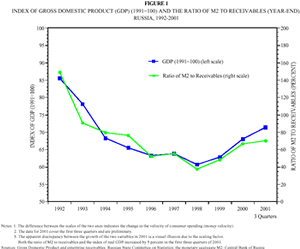
The analysis and evidence are consistent with the Great Russian Contraction, a decline of nearly half in economic output. The Russian economy reversed direction in 1999, growing at 3.5%. GDP grew at the remarkable rate of 8.3% in 2000, and continues to grow at 5% in 2001. If the postulated relationship between GDP dynamics and length of enterprise arrears is correct, it should hold for growth as well as contraction.
Return to the above example. If the average length of payments shortens from 3 to 2.4 months, the existing cash flow can buy 5 instead of 4 bundles of real output. GDP must grow by 25 percent.
Figure 1 reveals a change in the slope of both lines between 1998 and 1999 (the Great Default occurred on August 17, 1998). The data for 1999-2001 exhibit a continuous fit between the index of GDP and the ratio of the money stock to receivables. The fit is both in the direction and, over the entire period 1992-2001, in the relative magnitude change (elasticity) of both variables. Due to the scaling factor, the diagram exaggerates the annual fluctuations of this relationship. An apparent discrepancy in 2001 is a visual illusion. In fact, during the first three quarters of 2001, both the ratio of M2 to receivables and the index of real GDP increased by 5%.
Figure 2 employs a uniform scale for both the ratio of M2 to receivables and the index of real output. It shows that the ratio of the money stock to receivables closely matches economic growth in 2001 with the elasticity about unity. We will revisit this relationship and discuss it in more detail when the data for the full year 2001 become available.
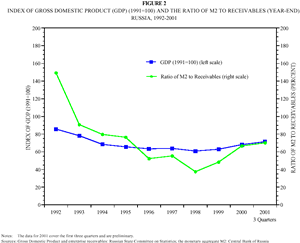
Russia's high growth since 1999 caught most observers by surprise. They offered various ad hoc explanations (e.g., devaluation, high oil prices, etc.). They treated economic growth in 1999-2001 as an isolated episode which has no common denominator with the Great Contraction of 1992-98. This makes it difficult to draw policy lessons for long-term growth.
Our analysis links the growth of 1999-2001 with the contraction of 1992-98 in assessing the same underlying factor. It is higher or lower accumulation of enterprise arrears, depending on whether enterprises are free to extract more subsidy or less subsidy. What has been different in the past few years is that government policy inadvertently decelerated enterprise arrears and reduced the subsidy. The policy belongs to the Central Bank, which effectively runs Russian fiscal policy.
The Central Bank imposed capital controls in 1998-99: it required mandatory repatriation of 75% of foreign exchange revenues by Russian exporters. Russia's reserves have risen to $38.5 billion, and the ruble has become relatively stable. (This percentage was reduced to 50% by an act of the Duma this past summer.) The Central Bank's policy was not explicit fiscal policy, let alone growth policy. It did not, nor could it, target fiscal policy and growth. It targeted monetary policy, and only a narrow aspect of it: the exchange rate. It also targeted capital flows. The explicit objective was having the right of first refusal in purchasing foreign exchange, with the eye on lending to the government for paying the external debt.
Fiscal, monetary, and external flow policies in Russia do not function in the same straightforward and compartmentalized ways as is customary in market economies. Lengthy and unpredictable delays in payments between enterprises result in massive income redistribution throughout the economy (and have the undesirable side effect of keeping value-subtracting enterprises afloat—we estimate value subtraction in industry at a third of output). When the Central Bank imposed capital controls, it truncated, indeed guillotined the principal enterprise subsidy in Russia: the subsidy for the accumulation of arrears. This worked through two related channels, one automatic and the other, deliberate choice:
1. When enterprises were forced to repatriate foreign exchange revenues, their revenues became exposed to the tax authority in the cash flow sense. Not just on the books but in the banks. They had to remit more taxes than before. This is because the government could now enforce more tax remittance without endangering the production flow and the tax flow on the part of cash-starved enterprises. Tax non-remittance is the principal component of the enterprise subsidy in Russia and the core of its automatic, self-enforceable mechanism. This subsidy was cut and its enforcement mechanism curtailed. Enterprises could expect smaller subsidy as its self-enforcement was constrained. Then enterprises reduced their accumulation of domestic trade arrears. This automatically, gradually dissolved the stock of receivables, increased the speed of payments, reduced the length of payments. Hence, more output: a gradual and accelerated economic growth as the ratio of money to receivables increased.
2. Enterprises started to dissipate the stock of arrears deliberately, by choice, not just automatically. As of September 2001, enterprises still owed the government a great stock of un-remitted tax liabilities: 695.6 billion rubles. With more cash flow available, enterprises had to either repay this liability to the government faster or pay-off their trade payables to other enterprises faster and reduce their cash balances in the bank. The second option is preferable from the enterprise standpoint: they have to repay their trade payables to suppliers in any case. If they pay faster, they obtain more inputs; but if they pay the tax debt to the government, they just reduce a paper liability and lose cash for nothing. So they chose the second option. This is how improved external earnings, due to higher world prices for energy, seeped through to the domestic economy. Faster dissipation or slower accumulation of the stock of receivables relative to money balances increased output throughout the economy, across the supply chains.
High energy prices in 2000-01 magnified these effects but could not, by themselves, produce it. The same Central Bank policy would have generated GDP growth even without rising energy prices, only lower growth. High energy prices without capital controls would have increased capital outflow and, possibly, contributed modestly to growth in the energy sector only. High energy prices made a quantitative difference. Central Bank policy made the qualitative difference.
On its face, the Central Bank policy is unorthodox, illiberal, and anti-reform. It constitutes a fundamental reversal of Russian IMF-instilled reforms of 1992-98. And yet, this policy is most productive because it reduces enterprise subsidies, thwarts income redistribution, and constrains counter-productive, predatory incentives. Public subsidy of ostensibly private enterprises is still socialism, albeit in a different form from the former Soviet version. Until these subsidies are curtailed, and enterprises are forced to compete in genuine markets, the Russian economy will be subject to the vagaries of energy prices and ostensibly illiberal policies.
Falling energy prices, coupled with less repatriation of foreign earnings, has already slowed growth If prices continue to fall, the reduction in repatriation of export revenues (the flip side of this is an increase in capital outflow, or in IMF-parlance, liberalization of capital flows) will halt growth and Russia will resume contraction.







